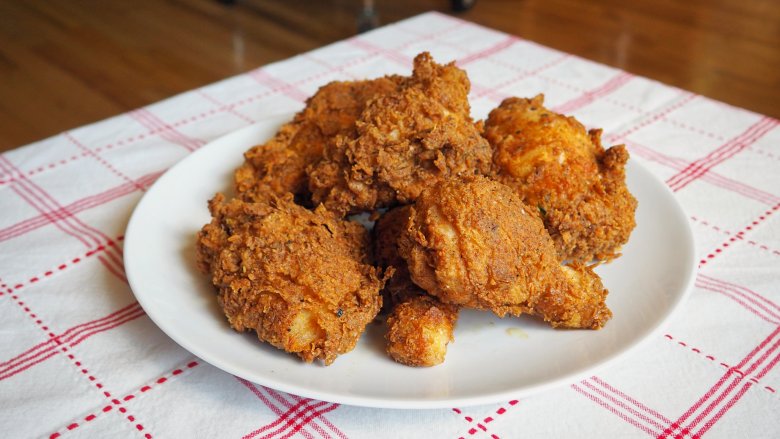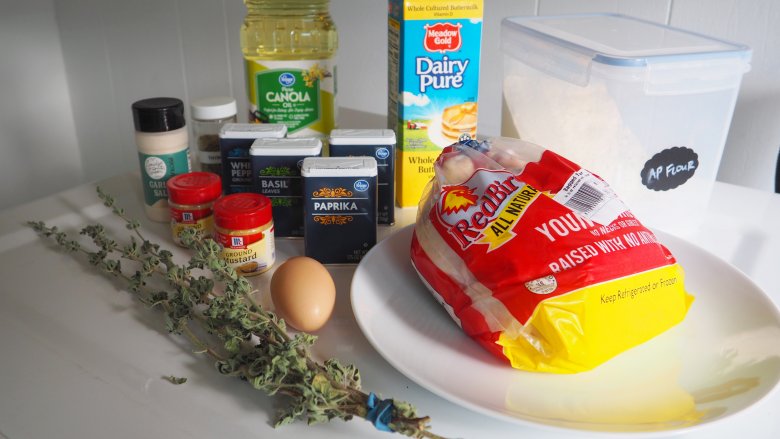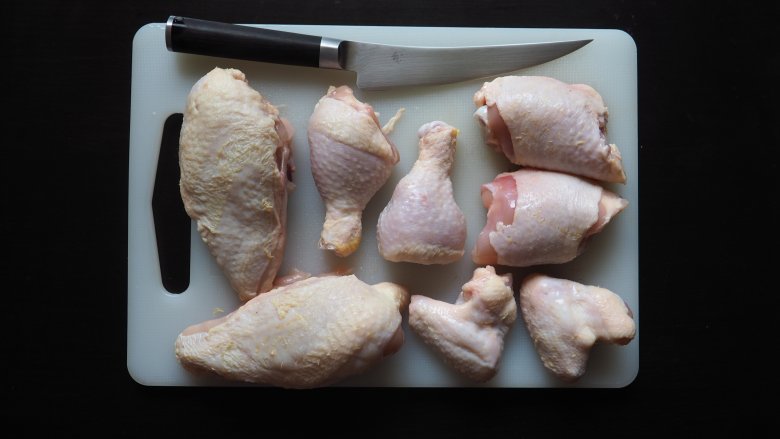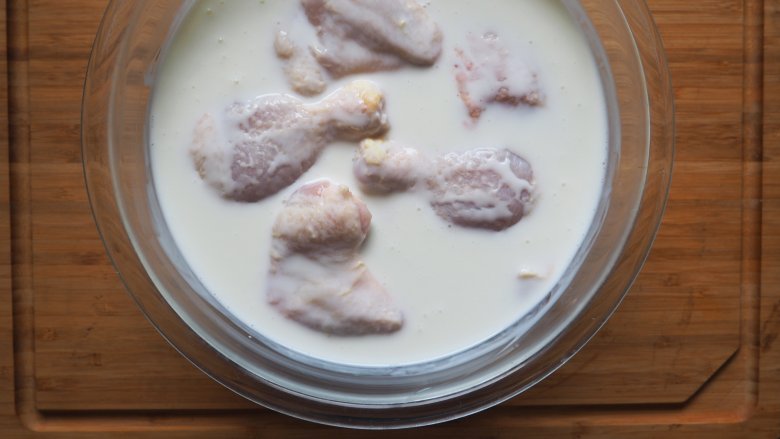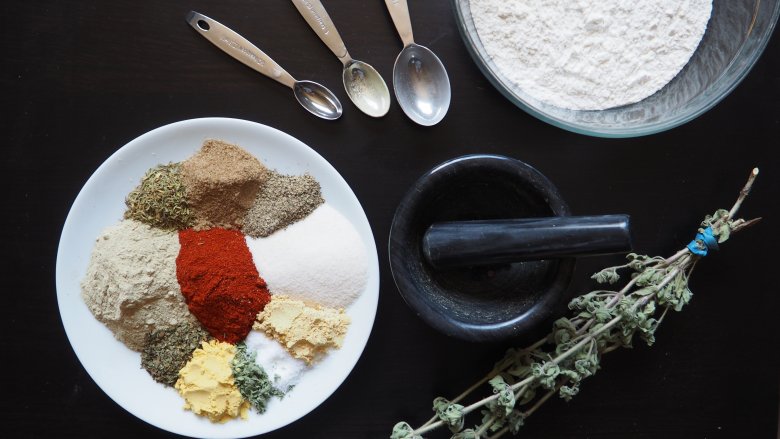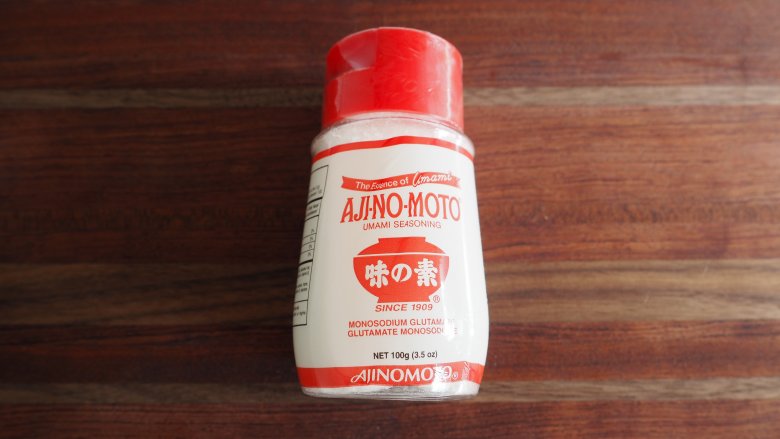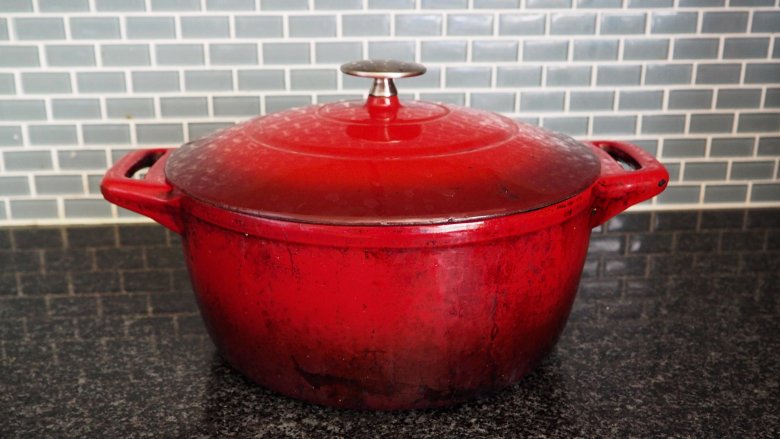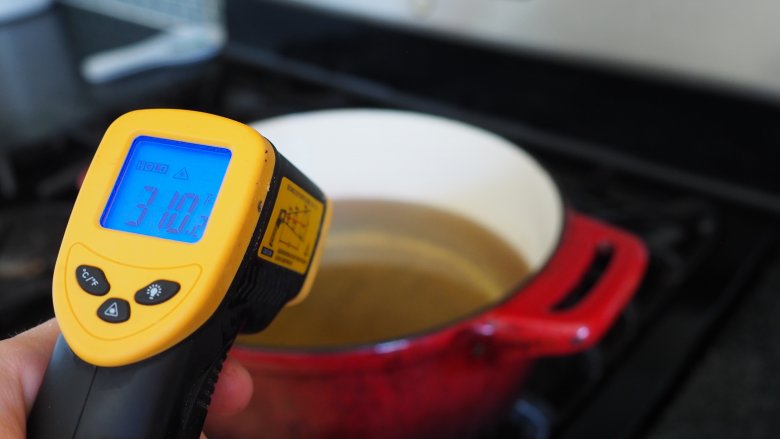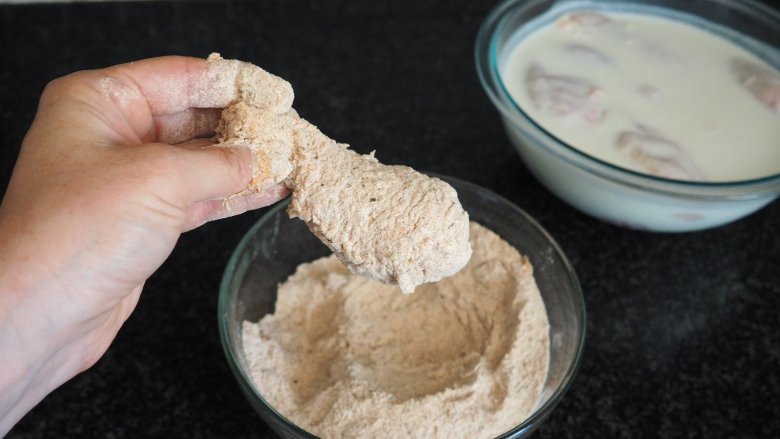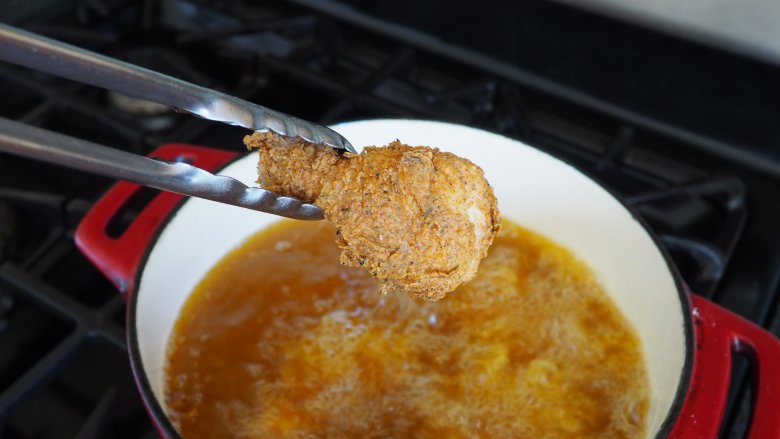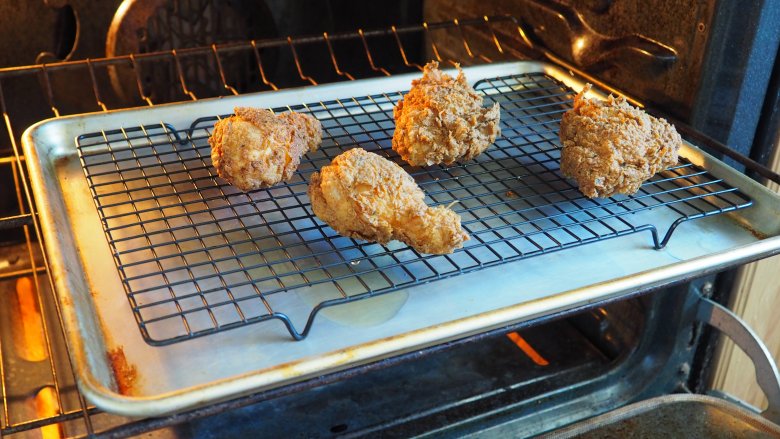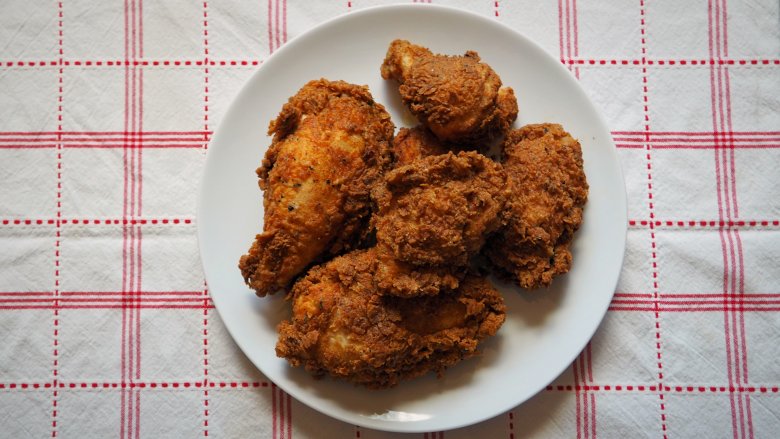Easy Copycat KFC Chicken Recipe
We may receive a commission on purchases made from links.
There's something nostalgic about a bucket of KFC Original Recipe Chicken. Growing up, most of us didn't have parents that were willing to fry chicken at home, so KFC became something of a special occasion food. It made an appearance at block parties, Fourth of July celebrations, and end-of-season soccer tournaments, wowing us with its salty, greasy, spicy, and flavorful crust. If you didn't grab a piece early enough, you'd end up with the one at the bottom of the bucket, stripped of its extra crispy skin by someone with a voracious appetite (also known as the saddest thing ever).
The original Colonel Sanders might have hated what the restaurant became after he sold, but we still think their chicken is "finger lickin' good." So why even attempt to make it at home? For starters, its less expensive, and you can use higher quality ingredients in your home kitchen. But, mostly, we wanted to see if the rumors spilling the beans on the secret blend of 11 herbs and spices were true. In the end, it was easier than we thought to make fried chicken that tasted as good (if not better) than what you'll find at KFC. But, you do need to know a few secrets along to way to ensure your chicken turns out juicy on the inside and crispy on the outside.
Pick up the ingredients for your copycat KFC chicken
KFC's chicken isn't any more complicated than most fried chicken recipes, although it does contain more ingredients. The flavorful coating is created by combining flour with 11 herbs and spices, so get ready to load up the grocery cart with salt, dried thyme, dried basil, dried oregano, celery salt, ground black pepper, ground yellow mustard, paprika, garlic salt, ground ginger, and ground white pepper. You'll need as much as a quarter cup of some of these spices, so make sure you have plenty on the spice rack before you get started. The full list of ingredients (along with the step-by-step instructions) can be found at the end of this article.
In addition to the spices, you'll also need a whole chicken, neutral oil for frying (like canola or peanut), buttermilk, a large egg, and all-purpose flour. Finally, be sure to have some measuring spoons handy, as well as a few mixing bowls, a large pot or electric tabletop fryer, and a baking sheet lined with an oven-safe rack.
The first step to copycat KFC chicken is breaking down a whole chicken
The most economical way to make this dish is to break down a chicken yourself. It's easier than you think, but you can always ask the butcher to do it for you if the process seems overwhelming. Or, swap-in all thighs, drumsticks, or chicken breasts. If choosing the latter, seek out bone-in chicken breasts, as fried chicken is always more tender when it's cooked on the bone.
To break down the chicken, start with the breast-side up and the neck opening facing towards you. Remove the wishbone by slicing along each side, using your fingers to pull the tiny bone straight out. Then, remove the legs and thighs by pulling the drumstick towards you and away from the body. Slice through the skin to expose the joint. Firmly twist the leg away from the body until the joint pops out of the socket. Slice through the exposed joint and pull the leg to free it. Cut through the joint connecting the drumstick and the thigh to separate the two pieces. Repeat the process with the second leg.
Next, hold the chicken vertically and carefully run your knife down along the ribs to remove the back from the breastbone. Remove the wings by pulling each one away from the body to expose the joint. Slice through the joint and cut around the drumette to remove it from the breast. Finally, keeping it on the bone, slice the chicken breast in half to make it easier to cook.
A buttermilk marinade keeps the chicken tender and juicy
As far as we can tell, KFC does not brine their chicken before frying it. That said, after doing side-by-side tests, we determined that marinating the chicken in buttermilk was the only way to create chicken as juicy as KFC's. KFC uses pressure fryers to keep their chicken moist as it cooks (something we'll talk about in a minute). Brining chicken helps it retain more moisture, and Serious Eats suggests soaking the chicken in buttermilk instead of a saltwater solution. The buttermilk has the added benefit of tenderizing the meat, and adding an egg to the mix creates a stronger structure for the breading to stick to later.
So, grab a large bowl and whisk the buttermilk and egg until they're well blended and homogenized. Add the chicken pieces and let them marinate for 20 to 30 minutes. If you're a plan-ahead kind of person, place the bowl in the refrigerator to marinate overnight. Don't let the mixture sit for longer than 24 hours or the chicken will become mushy.
The secret behind KFC's 11 herbs and spices
While your chicken is marinating, it's time to prepare the breading. KFC's blend of 11 herbs and spices was a closely guarded secret until 2016. A Chicago Tribune reporter took a trip to Kentucky to visit Colonel Harland Sanders' nephew, Joe Ledington. They found a recipe in an old scrapbook titled, "11 spices – Mix With 2 Cups White Fl." After extensive testing and confirmation from Ledington, who "used to blend the spices that went into his uncle's world-famous fried chicken," they determined that the recipe was legit.
There have been several other copycat versions floating around the internet before and since this one, but this particular recipe is the closest thing we've tasted to the real deal. We will say it has significantly larger quantities of spices than most recipes. If you don't want to go through the trouble of measuring the spice mix every time you want to make fried chicken, Tablespoon suggests doubling it up. You can store it in an airtight container for up to three months.
But the real secret to copycat KFC chicken is MSG
There is one teeny, tiny ingredient missing from the secret recipe uncovered by the Chicago Tribune: monosodium glutamate (MSG). When their test kitchen tried out the famous chicken recipe, it was close to the original, "yet something was still missing." After sprinkling a few shakes of flavor-enhancing Accent MSG seasoning, the chicken was virtually indistinguishable from the Colonel's. They went on to say that a spokesperson for KFC confirmed that MSG is used in Original Recipe Chicken, although they were unclear exactly how much is used.
The writers for the Chicago Tribune aren't the only ones who believe MSG is the real secret ingredient. Ron Douglas, author of America's Most Wanted Recipes, claims to have cracked the secret recipe in 2009. Douglas told Newsday the secret is "an abundance of Accent, a brand of the flavor enhancer MSG." By abundance, he means a whopping two tablespoons (as published in the The Guardian). We can't say we were willing to add that much MSG to our recipe, so we just sprinkled a little bit on at the end.
KFC uses pressure fryers, but we used a Dutch oven
Before we start frying, we have to point out an important fact: One of the reasons KFC's fried chicken is so delicious is because they use pressure fryers. According to Slate, Harland Sanders did something very dangerous when he opened his restaurant back in the 1940s and put oil (rather than water) in a regular pressure cooker. The idea behind cooking under pressure is that you can heat water hotter than its normal boiling point of 212 degrees Fahrenheit, cooking food faster and more efficiently. The same idea worked with oil — it was able to get much hotter than a regular deep fryer, cooking the chicken more quickly.
Today, KFC still pressure cooks their fried chicken, although much more safely using commercial pressure fryers. Since most of us don't have one of those (and we can't emphasize enough that you should not put fryer oil in your pressure cooker), we used a Dutch oven instead. If you happen to have an electric tabletop fryer, that will work, too.
Heat the fryer oil to 350 degrees Fahrenheit
The hardest part about frying chicken on the bone is getting the insides to cook through without burning the outside. According to the United States Department of Agriculture (USDA), poultry must be cooked to a minimum internal temperature of 165 degrees Fahrenheit. That's kind of tricky when it comes to frying bone-in chicken because it takes longer to cook than boneless chicken. And, when frying food, the hot oil creates a crust on the food's surface, preventing the oil from getting through to the inside. That's great for creating crispy exteriors but not so great for cooked-through interiors. If you lower the temperature to try to help equalize the cooking, the oil will be too cool to crisp up the outside, creating soggy fried chicken.
To get around this, Taste of Home suggests heating the oil to 350 degrees. This is the perfect temperature to create a golden-brown crust in about 12 minutes. Then, if the chicken still isn't cooked all the way through, you can finish cooking the pieces in the oven until they reach the proper internal temperatures. That method actually works in your favor because you can't fry the entire chicken in one batch anyway. Holding the tasty copycat KFC chicken in the oven allows it to finish cooking and it keeps the cooked chicken warm while you finish frying the remaining pieces.
Dredge the chicken in the flour mixture, but don't let it sit too long
Now that your fryer oil is nice and hot, it's time to fry. We would be remiss if we didn't warn you that you're going to get messy in this step. There is absolutely no way to avoid creating a claw-like coating on your fingers as you combine the buttermilk-coated chicken with the dry flour. You can try to minimize the damage by using one hand to grab the chicken out of the buttermilk and the other to coat it in flour, but you'll still get a little messy.
We found the best method here was to dip the chicken into the flour one time only, pushing it down hard to make sure the flour adheres. If you just try to dunk-and-go, the coating will fall off as the chicken fries. And, if you try to double dip — coating with buttermilk and flour again after the initial coating — the crust will become too thick and won't be as crispy as the single coat.
The other key to success here is to go straight from the flour into the hot oil. Many recipes call for resting the chicken for a period of time after coating it in flour, but we didn't like the way that chicken tasted. In his book The Food Lab: Better Home Cooking Through Science, J. Kenji López-Alt confirms that rested dredged chicken gives the flour time to absorb too much moisture. That led to a tough, brittle crust instead of the crispy, crunchy exterior we were going for.
Always let the oil come back up to temp before adding more chicken
When it comes to frying food, there are two important rules: don't overcrowd the fryer, and always wait for the temperatures to return to normal before frying the next batch. The basic principle is the same for both rules. When you add cold or room temperature food to a hot fryer, the temperature of the oil will drop. If the temperature gets too low, the coating on the chicken will absorb too much oil, becoming sad and soggy.
Your best bet to maintain the right frying temperature is to let the oil preheat to 350 degrees Fahrenheit before adding any chicken. Then, don't overcrowd the pan too much; in our 8-quart Dutch oven, we fried the chicken in two batches, cooking only four pieces of chicken at one time. After about 12 minutes, the first batch should be golden brown and crispy, but you can't add the second batch right away. It's important to wait for the temperature to return to 350 degrees before adding more chicken.
Hot hold the chicken in the oven before serving
When Reader's Digest interviewed a former KFC employee, they learned how they store the chicken in a 175 degree Fahrenheit oven after frying it. It stays there for 20 minutes before being packaged and served. We were a little apprehensive about this step — wouldn't keeping the chicken in the oven for that long cause the skin to become soft? As it turns out, this tip totally works. Storing the chicken in a warm oven not only ensured the chicken finished cooking all the way through, but it also kept the skin nice and crunchy.
The key component of this step is making sure the chicken doesn't touch the bottom of the sheet pan. We wanted the chicken to have contact with the air only, so we kept it elevated on an oven-safe wire cooling rack. This not only allowed the air to circulate around the chicken to keep it crispy, but it also let the excess grease drain through the rack. For easy clean-up, you'll want to line the baking sheet with aluminum foil first.
How close did we get to KFC chicken?
The first thing we noticed about our copycat fried chicken was the aroma; it was absolutely intoxicating. All those herbs and spices activated in the hot fryer oil, and we could barely wait to let the chicken cool before taking a bite. We were pleasantly surprised that the combination of the 350 degree Fahrenheit oil and hot-holding the chicken in the oven created a crispy-on-the-outside exterior with a super juicy, perfectly moist interior.
When it came to flavor, we were pretty excited about how the chicken tasted. It was almost better than the original! The coating was lightly spicy and full-flavored, although it was a touch on the salty side at first bite. Finishing each piece with a sprinkle of MSG actually mellowed out the salt and boosted the umami-rich flavor. Our only complaint? Our chicken was ever so slightly less crispy than KFC's. But, we don't have a pressure fryer, so we can't complain too much. Serve it up next to our KFC copycat coleslaw recipe, and you have a winner.
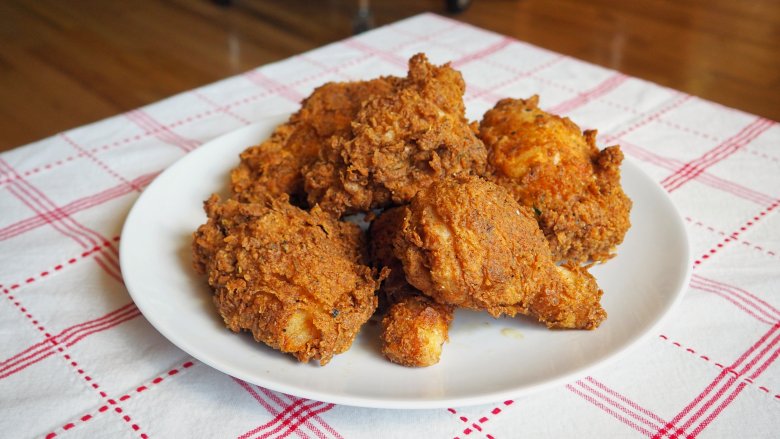
- 2 cups all-purpose flour
- 2 teaspoons salt
- 1-½ teaspoons dried thyme leaves
- 1-½ teaspoons dried basil leaves
- 1 teaspoon dried oregano leaves
- 1 tablespoon celery salt
- 1 tablespoon ground black pepper
- 1 tablespoon ground yellow mustard
- ¼ cup paprika
- 2 tablespoons garlic salt
- 1 tablespoon ground ginger
- 3 tablespoons ground white pepper
- 1 cup buttermilk
- 1 egg, beaten
- 1 chicken, cut up into eight pieces
- Neutral oil for frying, like canola or peanut oil
- MSG seasoning, like Ajinomoto or Accent
- In a large bowl, combine the flour with the herbs and spices and set aside.
- Meanwhile, in another large bowl, whisk together the buttermilk and egg, mixing until they're well combined.
- Add the chicken to the buttermilk bowl and toss to coat. Cover the bowl lightly with plastic wrap or a lid and let it sit for 30 minutes, or as long as overnight. If marinade times exceed 30 minutes, place the bowl in the refrigerator.
- Meanwhile, preheat the oven to 175 degrees Fahrenheit. Line a baking sheet with aluminum foil. Set an oven-safe wire cooling rack inside the sheet and set aside.
- In a large Dutch oven, heat about 3 inches of oil. If you're using an electric tabletop fryer, fill the unit to its MAX line.
- Preheat the oil to 350 degrees over medium-high heat, using a deep-frying thermometer to check the temperature. When the oil reaches 350 degrees, reduce the heat to medium-low.
- Remove a chicken piece from the buttermilk, allowing any excess liquid to drip off. Place the piece in the flour mixture and press down firmly, allowing the flour to adhere on all sides. Shake off any excess flour and carefully drop the chicken into the hot oil. Continue dredging chicken until the fryer is full but not overcrowded; you should be able to fry three to four pieces at a time.
- Cook the chicken for about 12 minutes, turning halfway through, until the crust turns an appealing golden brown color.
- Transfer the chicken pieces to the prepared baking sheet and place it in the oven.
- Allow the oil to return to temperature before adding more chicken. Repeat the dredging and frying process with the remaining pieces of chicken.
- When all the chicken is fried, let the pieces sit in the oven until each reaches an internal temperature of 165 degrees.
- Sprinkle each piece of chicken with a few shakes of MSG before serving. If you're unsure about food additives like MSG, feel free to skip the extra seasoning.
| Calories per Serving | 1,594 |
| Total Fat | 118.2 g |
| Saturated Fat | 19.1 g |
| Trans Fat | 0.6 g |
| Cholesterol | 267.4 mg |
| Total Carbohydrates | 65.0 g |
| Dietary Fiber | 7.0 g |
| Total Sugars | 4.1 g |
| Sodium | 1,232.0 mg |
| Protein | 68.6 g |
